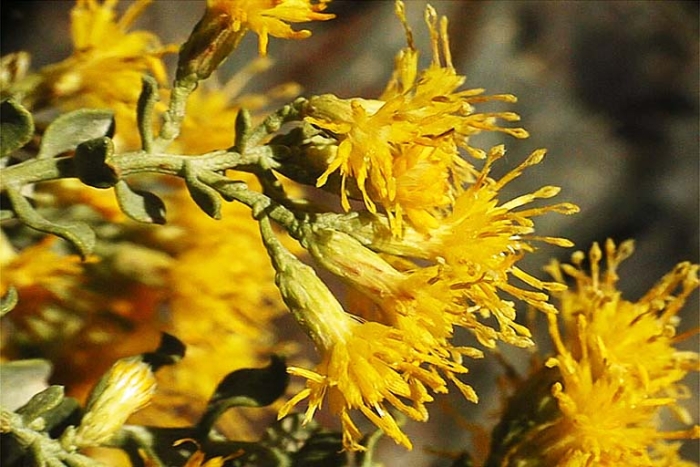Cliff Goldenbush
(Ericameria cuneata)
Cliff Goldenbush (Ericameria cuneata)
/
/

Larry Blakely
Public Domain
Image By:
Larry Blakely
Recorded By:
Copyright:
Public Domain
Copyright Notice:
Photo by: Larry Blakely | License Type: Public Domain | License URL: http://creativecommons.org/licenses/publicdomain/ | Attribution: 1998 Larry Blakely | Publisher: Calphotos |

































































Estimated Native Range
Summary
Ericameria cuneata, commonly known as Cliff Goldenbush, is a semi-deciduous subshrub or shrub native to the chaparral and desert regions of California and Baja California. This plant is well-adapted to dry, rocky slopes and canyons, thriving in its native habitat’s harsh conditions. It usually reaches up to 100 cm (40 inches) in height and is characterized by its small, glandular, wavy-edged leaves that are rounded, oval-shaped, and up to 2.5 centimeters (1 inch) long, often with visible resin glands. The many erect branches culminate in inflorescences of several golden yellow flower heads, each with a few to 70 disc florets and occasionally a few short ray florets, blooming from late summer to fall.
Cliff Goldenbush is valued for its drought tolerance and vibrant yellow flowers that add color to the garden when many other plants have finished blooming. It is suitable for xeriscaping, rock gardens, and native plant landscapes. This plant is also beneficial to pollinators, attracting bees and butterflies. It requires minimal maintenance, thriving in full sun and tolerating a range of soil types, provided they have good drainage. While it is generally disease-free, it can be susceptible to root rot if overwatered.CC BY-SA 4.0
Cliff Goldenbush is valued for its drought tolerance and vibrant yellow flowers that add color to the garden when many other plants have finished blooming. It is suitable for xeriscaping, rock gardens, and native plant landscapes. This plant is also beneficial to pollinators, attracting bees and butterflies. It requires minimal maintenance, thriving in full sun and tolerating a range of soil types, provided they have good drainage. While it is generally disease-free, it can be susceptible to root rot if overwatered.CC BY-SA 4.0
Plant Description
- Plant Type: Subshrub, Shrub
- Height: 0.4-1 feet
- Width: 0.4-1.5 feet
- Growth Rate: Moderate
- Flower Color: Yellow
- Flowering Season: Fall, Summer
- Leaf Retention: Semi-Deciduous
Growth Requirements
- Sun: Full Sun
- Water: Low
- Drainage: Medium, Fast
Common Uses
Bee Garden, Bird Garden, Butterfly Garden, Low Maintenance, Rock Garden
Natural Habitat
native to the chaparral and desert regions of California and Baja California
Other Names
Common Names:
Scientific Names: , Ericameria cuneata, Ericameria cuneata var. cuneata, Ericameria cuneata var. spathulata, Haplopappus cuneatus, Bigelowia rupestris, Haplopappus cuneatus var. spathulatus, Aster cuneatus, Chrysoma cuneata, Chrysoma cuneata var. cuneata
GBIF Accepted Name: Ericameria cuneata (A.Gray) Mc Clatchie